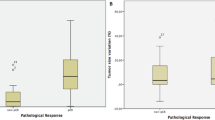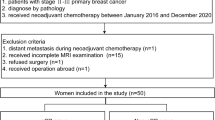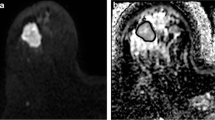Abstract
Objective
To evaluate the role of mean diffusivity (MD) as a predictive index of the response to chemotherapy in locally advanced breast cancer.
Methods
Twenty-one women referred to our institution with a diagnosis of locally advanced breast cancer underwent magnetic resonance imaging (MRI) studies at 1.5 T before beginning and after completing combined neoadjuvant chemotherapy. The examination protocol included an EPI sequence sensitised to diffusion (b-value 1,000 s/mm2) and three-dimensional (3D) coronal T1 sequences before and after intravenous contrast medium. Tumours were delineated by using dynamic MR acquisition before and after chemotherapy. The percentage of tumour volume reduction (PVR) and pre-(MDpre) and post-therapy (MDpost) MD values were computed for each lesion.
Results
PVR ≥ 65% was observed in 17/21 patients (responders). MDpre of responders (0.99 ± 0.27 10−3 mm2/s) was significantly (p = 0.025) lower than MDpre of non-responders (1.46 ± 0.33 10−3 mm2/s). Moreover, in patients as a whole PVR significantly correlated (p = 0.01, r = −0.54) with MDpre. MDpost (1.26 ± 0.39 10−3 mm2/s) of responders was significantly(p = 0.024) higher than MDpre (0.99 ± 0.27 mm2 10−3 mm2/s), whereas non-responders MDpost (1.00 ± 0.14 10−3 mm2/s)did not increase compared with MDpre (1.46 ± 0.33 10−3 mm2/s).
Conclusions
This preliminary study seems to indicate that low values of pre-chemotherapy MD may identify, before starting treatment, the patients with higher probability of response in terms of percentage of volume reduction of the lesion. MD may represent a complementary parameter useful to correctly select patients for neoadjuvant chemotherapy.






Similar content being viewed by others
References
Green FL, Page DL, Fleming ID et al (2002) Part VII breast. In: AJCC cancer staging handbook, 6th edn. Springer, Berlin, pp 255–281
Londero V, Bazzocchi M, Del Frate C, Puglisi F, Di Loreto C, Francescutti G, Zuiani C (2004) Locally advanced breast cancer: comparison of mammography, sonography and MR imaging in evaluation of residual disease in women receiving neoadjuvant chemotherapy. Eur Radiol 14:1371–1379
Basser PJ, Mattiello J, Le Bihan D (1994) Estimation of the effective self-diffusion tensor from the NMR spin-echo. J Magn Reson B 103:247–254
Le Bihan D, Mangin JF, Poupon C, Clark CA, Pappata S, Molko N, Chabriat H (2001) Diffusion tensor imaging: concepts and applications. J Magn Reson Imaging 13:534–546
Neil J, Miller J, Mukherjee P, Huppi S (2002) Diffusion tensor imaging of normal and injured developing human brain: a technical review. NMR Biomed 15:543–552
Woodhams R, Matsunaga K, Iwabuchi K, Kan S, Hata H, Kuranami M, Watanabe M, Hayakawa K (2005) Diffusion-weighted imaging of malignant breast tumors: the usefulness of apparent diffusion coefficient (ADC) value and ADC map for the detection of malignant breast tumors and evaluation of cancer extension. J Comput Assist Tomogr 29:644–649
Sinha S, Lucas-Quesada FA, Sinha U, DeBruhl N, Bassett LW (2002) In vivo diffusion-weighted MRI of the breast: potential for lesion characterization. J Magn Reson Imaging 15:693–704
Marini C, Iacconi C, Giannelli M, Cilotti A, Moretti M, Bartolozzi C (2007) Quantitative diffusion-weighted MR imaging in the differential diagnosis of breast lesion. Eur Radiol 17:2646–2655
Guo Y, Cai YQ, Cai ZL, Gao YG, An NY, Ma L, Mahankali S, Gao JH (2002) Differentiation of clinically benign and malignant breast lesions using diffusion-weighted imaging. J Magn Reson Imaging 16:172–178
Hatakenaka M, Soeda H, Yabuuchi H, Matsuo Y, Kamitani T, Oda Y, Tsuneyoshi M, Honda H (2008) Apparent diffusion coefficients of breast tumors: clinical application. Magn Reson Med Sci 7:23–29
Hamstra DA, Chenevert TL, Moffat BA, Johnson TD, Meyer CR, Mukherji SK, Quint DJ, Gebarski SS, Fan X, Tsien CI, Lawrence TS, Junck L, Rehemtulla A, Ross BD (2005) Evaluation of the functional diffusion map as an early biomarker of time-to-progression and overall survival in high-grade glioma. Proc Natl Acad Sci USA 102:16759–16764
Hayashida Y, Yakushiji T, Awai K, Katahira K, Nakayama Y, Shimomura O, Kitajima M, Hirai T, Yamashita Y, Mizuta H (2006) Monitoring therapeutic responses of primary bone tumors by diffusion-weighted image: initial results. Eur Radiol 16:2637–2643
Pickles MD, Gibbs P, Lowry M, Turnbull LW (2006) Diffusion changes precede size reduction in neoadjuvant treatment of breast cancer. Magn Reson Imaging 24:843–847
Chenevert TL, Meyer CR, Moffat BA, Rehemtulla A, Mukherji SK, Gebarski SS, Quint DJ, Robertson PL, Lawrence TS, Junck L, Taylor JM, Johnson TD, Dong Q, Muraszko KM, Brunberg JA, Ross BD (2002) Diffusion MRI: a new strategy for assessment of cancer therapeutic efficacy. Mol Imaging 1:336–343
Theilmann RJ, Borders R, Trouard TP, Xia G, Outwater E, Ranger-Moore J, Gillies RJ, Stopeck A (2004) Changes in water mobility measured by diffusion MRI predict response of metastatic breast cancer to chemotherapy. Neoplasia 6:831–837
Manton DJ, Chaturvedi A, Hubbard A, Lind MJ, Lowry M, Maravejas A, Pickles MD, Tozer DJ, Turnbull LW (2006) Neoadjuvant chemotherapy in breast cancer: early response prediction with quantitative MR imaging and spectroscopy. Br J Cancer 94:427–435
Sharma U, Danishad K, Seenu V, Jagannathan N (2009) Longitudinal study of the assessment by MRI and diffusion-weighted imaging of tumor response in patients with locally advanced breast cancer undergoing neoadjuvant chemotherapy. NMR Biomed 22:104–113
Belli P, Costantini M, Malaspina C, Magistrelli A, LaTorre G, Bonomo L (2006) MRI accuracy in residual disease evaluation in breast cancer patients treated with neoadjuvant chemotherapy. Clinical Radiology 61:946–953
Pickles MD, Lowry M, Manton DJ, Gibbs P, Turnbull LW (2005) Role of dynamic contrast enhanced MRI in monitoring early response of locally advanced breast cancer to neoadjuvant chemotherapy. Breast Cancer Res Treat 91:1–10
Partridge SC, Gibbs JE, Lu Y, Esserman LJ, Tripathy D, Wolverton DS, Rugo HS, Hwang ES, Ewing CA, Hylton NM (2005) MRI measurements of breast tumor volume predict response to neoadjuvant chemotherapy and recurrence-free survival. AJR Am J Roentgenol 184:1774–1781
Dudeck O, Zeile M, Pink D, Pech M, Tunn PU, Reichardt P, Ludwig WD, Hamm B (2008) Diffusion-weighted magnetic resonance imaging allows monitoring of anticancer treatment effects in patients with soft-tissue sarcomas. J Magn Reson Imaging 27:1109–1113
Rajan R, Poniecka A, Smith TL, Yang Y, Frye D, Pusztai L, Fiterman DJ, Gal-Gombos E, Whitman G, Rouzier R, Green M, Kuerer H, Buzdar AU, Hortobagyi GN, Symmans WF (2004) Change in tumor cellularity of breast carcinoma after neoadjuvant chemotherapy as a variable in the pathologic assessment of response. Cancer 100:1365–1373
Ogston KN, Miller ID, Payne S et al (2003) A new histological grading system to assess response of breast cancers to primary chemotherapy: prognostic significance and survival. Breast 12:320–327
Ross BD, Moffat BA et al (2003) Evaluation of Cancer Therapy Using Diffusion Magnetic Resonance Imaging. Mol Cancer Ther 2:581–587
Roth Y, Tichler T, Kostenich G, Ruiz-Cabello J, Maier SE, Cohen JS, Orestein A, Mardor Y (2004) High-b-value diffusion-weighted MR imaging for pretreatment prediction and early monitoring of tumor response to therapy in mice. Radiology 232:685–692
Author information
Authors and Affiliations
Corresponding author
Rights and permissions
About this article
Cite this article
Iacconi, C., Giannelli, M., Marini, C. et al. The role of mean diffusivity (MD) as a predictive index of the response to chemotherapy in locally advanced breast cancer: a preliminary study. Eur Radiol 20, 303–308 (2010). https://doi.org/10.1007/s00330-009-1550-z
Received:
Revised:
Accepted:
Published:
Issue Date:
DOI: https://doi.org/10.1007/s00330-009-1550-z




